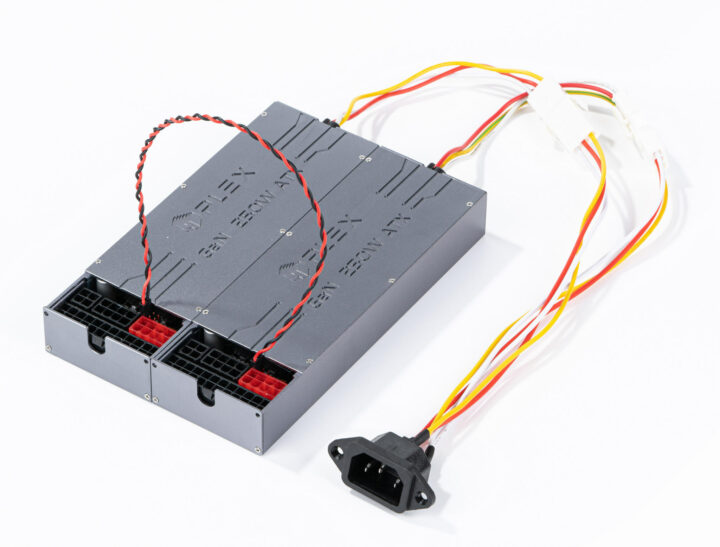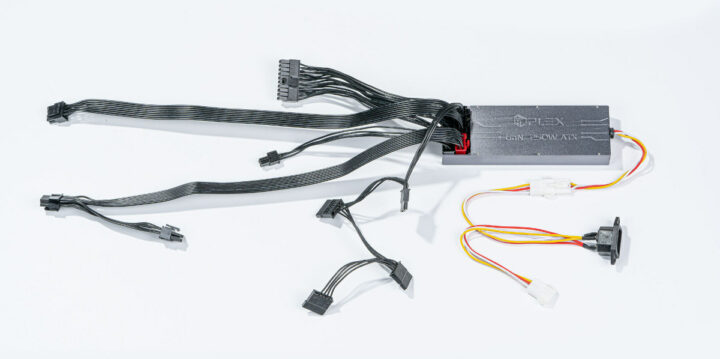To me, an ATX power supply is one of those big boxes delivering 500W+ inside a PC tower, but since it’s not possible to create hardware with much lower power consumption, HDPLEX has designed an ultra-compact 250W passive ATX power supply using the same GaN (Gallium Nitride) technology as found in some tiny USB-C power supplies.
With a 170x50x25mm footprint, the company claims it is the world’s smallest ATX PSU, and it is especially well suited to SFF PC enclosures, but it should also work pretty well in other space-constraints applications with a board equipped with an ATX connector, or through an adapter board, or even some RGB LED projects.
GaN ATX power supply specifications:
- Wattage – 250W (94% Efficiency).
- Input Voltage – 90V-264V 50/60hz
- DC output
- +3.3V up to 10A
- +5V up to 10A
- +12V up to 20A
- -12V up to 1A
- +5VSb up to 3A
- Max combined power for +3.3V and +5V – 80 W
- Total Power – 250W
- Idle Power – <0.4W/0.1W
- Noise level – zero dB operation with fully passive/fanless design,
- PFC+LLC Structure, Level 5 energy efficiency
- 2x auto grade GaN FETs on PFC stage and 2x on LLC stage
- 1.18W/cm³ power density
- Three Stage AC input filter to eliminate grid noise
- 4x ATX 1KV 8A TTR8MF Full-wave rectification
- 150µF Rubycon filter CAP and 9000µF Solid Cap
- Protections – UVP, OVP, SCP, OPP, OTP (See Coolmaster article for an explanation of those terms)
- Detachable C14 IEC connector to support other AC input for custom projects
- Dimensions – 170 x 50 x 25 mm, (Aluminum shell casing to help dissipate heat)
- Temperature Range – -10°C – 75°C
If 250W is a bit tight on the power budget, it’s possible to connect (aka sync) two units for a combined 500W of output power. The PSU ships with several cables:
- 20 cm IEC C14 AC- two ELR connectors cable
- 25 cm 24-pin (20+4) ATX PSU cable
- 45cm CPU EPS 8-pin (4+4) cable
- 45cm PCIe with red connector with dual 8-pin (6+2) cable
- 45cm SATA power cable with 4x SATA power connector
- 45cm sync cable (45cm)
The HDPLEX 250W GaN All-In-One ATX PSU will be available in June for $145 with free worldwide shipping from warehouses in the US and Germany.
Via FanlessTech

Jean-Luc started CNX Software in 2010 as a part-time endeavor, before quitting his job as a software engineering manager, and starting to write daily news, and reviews full time later in 2011.
Support CNX Software! Donate via cryptocurrencies, become a Patron on Patreon, or purchase goods on Amazon or Aliexpress








The specs are really impressive. I do have one 12V/20A PSU that’s much bigger than this, thus I can appreciate the progress made. And here it’s ATX so a part of the volume is taken by the multiple outputs rectification and filtering. There are top and bottom PCB photos on their site. The transformer is really small, I think it must be running at quite a high frequency, which would indicate that GaN devices excel at high frequencies and high voltages.
One of the rare places where they could shave a few more percent of efficiency is the input rectifiers. By using active rectification they could probably save 1-1.5W and reach around 94.5% 🙂
They should make switching PSUs for audio applications. With this degree of compactness they could add large filtering on the output, and totally enclose them in metal to let no radiation out. This would be much better than these noisy toroidal transformers.
The dual connection IEC cable is mildly terrifying. I wouldn’t want 120V on exposed pins just dangling around inside my case.
Yeah that’s scary as it looks, but I guess they ship it with a plastic cap on it, as you often see on some connectors like HDMI or SFP modules. At least I hope.
Zoom the photo, they have white plastic connections
120V? Who’s scared of that? 230V is peanuts, 400V starts to hurt 🤣😂
Add an other zero and it won’t hurt (long).
The specs (besides watt/cm3) seem not impressive: Level V power efficiency seems not current? What is the 1% Load efficiency?
I thought a little tutorial on GaN might be helpful to understand this power supply.
GaN is a different transistor technology using different materials than normal Silicon transistors–Gallium and Nitrogen. It allows a lower conduction loss than silicon and a higher switching speed. GaN also tolerates higher temperatures that Si devices and has better thermal conductivity. This allows GaN devices to need less thermal management–heatsinks, fans, large masses of metal, etc. Given that they have lower electrical losses as well, the thermal issues for GaN designs can be signifigantly reduced compared to Si devices.
Lower switching losses allows the designs to use higher switching frequencies (for the same overall switching loss as Si) which allows the use of smaller inductors and capacitors.
So, GaN allows smaller, lighter, and/or more efficient designs–or some combination of those traits.
Thank for the explanation 👍
Thanks for the details. I just compared Si and GaN transistors from a same vendor (infineon) to compare their characteristics for a similar set of values. I picked 600V / 30A, the Si one (IPB65R075CFD7A) has 75mOhm and 68nC total charge, while the GaN one (IGT60R070D1) has 70mOhm for 5.8nC, hence same resistance but 12 times less charge. This indeed explains why they’re particularly interesting for power supply applications where the ability to crank up the frequency results in much smaller devices, and leaves room for oversized transistors that reduce losses.
Si transistors are very mature and reaching material limits while GaN is pretty new and has a lot of headroom to improve, so expect them to keep getting better. They also lack a body diode, so, if you’ve ever implemented a half or full bridge, you know the pain of MOSFETs. The low Vth is amazing to me considering you’re dealing with a 600V/30A device! Not only is the gate charge tiny, but the voltage swing is tiny, too, so the total gate energy is itty-bitty. What a great time to be a EE. 😉 Oh, and SiC isn’t horrible, either.
while a full bridge (e.g. active rectifying) might be ~$50 on 4 (GaN) mosfets (these days), some need somewhat more complex circuits for (negative) gate voltages
ATX length would have been more favorable (?), but apart from that, nice volume
Given we’re speaking about low-frequency on the primary, the usual high-value resistor+zener diode as found on ZVS oscillators should be sufficient, and regular mosfets would do the job fine.
What about PicoPSU-160-XT + any AC/DC brick?
The PicoPSU are nice, but they stlil require that AC/DC brick, and that brick’s size is all what this article is about.
Just to point out that there are photos of the guts in the hdplex article which can be accessed through the purchase link. So it’s not just an empty box with wires attached to show off some future design.